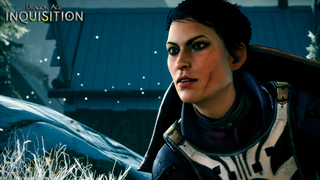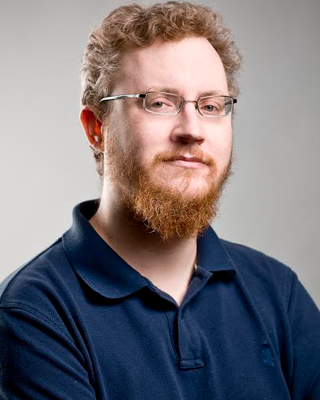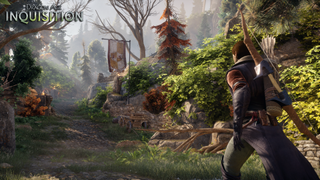
As part of our extensive hands-on session with Dragon Age: Inquisition, we also got to speak with the game’s executive producer Mark Darrah. Here he discusses what lessons were learned from the second game and explains why we may be entering a new renaissance for RPGs…
PC Gamer: So, coming off the back of Dragon Age 2, what was the big ambition for [Inquisition]? What were the things you wanted to do differently?

Mark Darrah: The big thing for us coming off Dragon Age 2 was really to get back to scale and all that entails. If you look at Bioware’s track record basically since Baldur’s Gate 2, our games have been getting progressively smaller. Our fidelity’s been getting higher and higher, but the scope has been getting smaller and smaller. I guess ultimately sort of coming down crashing around us with Dragon Age 2 to a certain degree. So, really, bringing exploration back as an actual thing—big spaces to move through, with a variety of mechanics and the things that come with that, visual storytelling through the environments, jumping which is actually something we’ve never had before, horseback riding, crafting is very much this thing that comes out of exploration as a gameplay mechanic. These are all things that come from basically getting the ambition and scope back.
PC Gamer: I was surprised when I saw jumping actually, because I didn’t expect it. Was that a desire for more of an open world, exploratory feel? Partly in response to the runaway success of Skyrim?
MD: Actually no, but it certainly it helped. We were already headed in this direction, this was already where we wanted to go. I mean, Frostbite [the engine which powers Dragon Age Inquisition] looks like it should be perfect for this because it’s got multiplayer levels that are 16km across and support jet fighters, but certainly Skyrim helped inform a lot of what this kind of game could—maybe not should—but at least could look like. I don’t think anyone expected Skyrim to be as successful as it was.

PC Gamer: Can you tell me a bit about developing it for console and PC, because I think some of the criticism levelled at Dragon Age 2 was because people felt there were compromises made to fit those two audiences. How have you attacked that particular problem this time around?
MD: Yeah, I mean the goal was to really get back to a more core experience. So, not always necessarily the experience that was in Dragon Age: Origins—in some cases just a more uncompromising role-playing experience. The UI is definitely the place where you see those compromises most often made. There’s a custom HUD for PC, and the inventory and the crafting are definitely places where we’ve tried to make sure the PC experience is designed PC-first. So it’s definitely been on our mind the whole time.
The biggest gaming news, reviews and hardware deals
Keep up to date with the most important stories and the best deals, as picked by the PC Gamer team.
PC Gamer: Talk to me about the tactical combat system and what the ethos of that was, and how much you expect the typical user to use it?
MD: What it’s really about is giving the player tools in their toolbox. So, if you’re playing on normal, you really just need mastery of one or two tools. You could use the tac cam, or you could get really good gear, or you could just play your character really well, or you could over-level through combat. On normal you could probably get away with doing one of those things, but on hard you’re going to need to do two of those things, and on nightmare you’re going to need to do all of those things.
Tac cam is really about being a time decompressor. You can pause the game and get additional information which allows you to plan more carefully, as if you basically had as much time as you wanted. Essentially you do have as much time as you want to plan what you’re going to do—issue commands, order people around. So that’s really what it’s about: giving you a more perfect understanding of the battlefield. But ultimately if you are sufficiently outmatched that can only help you so far, so you’re going to still need to know how to do other things as well.
I don't think anyone expected Skyrim to be as successful as it was.
PC Gamer: What did you guys take from the success of the Mass Effect games that has found its way into the DNA of Dragon Age?
MD: They’re definitely, at their hearts, different from a franchise perspective. Dragon Age is very much darker, and more mature, just from a tone perspective. Mass Effect is like a space opera. It’s essentially a teen rated IP at heart. It wants to be something that could be on television on a Sunday afternoon. Dragon Age, if it was a television show, would be on HBO. So, from a thematic story-telling perspective, they’re so different it’s hard for them to share. But if you look at the flow of gameplay from Mass Effect through 1, 2, and 3, they actually experiment with a lot of different things—like the Mako was in Mass 1 but not in Mass 2.
We’ve been able to take a lot of learning just from that—the experiences they’ve had with those different gameplay modalities, especially because when you have exploration as such a primary mechanic you need a lot of supplementary mechanics in there. Things to do in that space. In our case, we have horses but we don't go the route of Mass 1 where the Mako is this entirely different scale of thing which changes the balance of everything. For us, mounts are much more about getting somewhere faster and we leave the additional mechanics for a later time.
PC Gamer: Do you introduce new ways of getting Power and Influence as you go, or is it always a case of sealing rifts and opening camps?
MD: Sealing rifts remains a way to get power, as does opening camps, but there are other things. Doing quests and unlocking followers will get you power because they bring people with them. For the most part your followers are already leaders in their own right, so if you bring in Iron Bull he’s bringing his mercenary company with him, so power comes with that.
With over two decades covering videogames, Tim has been there from the beginning. In his case, that meant playing Elite in 'co-op' on a BBC Micro (one player uses the movement keys, the other shoots) until his parents finally caved and bought an Amstrad CPC 6128. These days, when not steering the good ship PC Gamer, Tim spends his time complaining that all Priest mains in Hearthstone are degenerates and raiding in Destiny 2. He's almost certainly doing one of these right now.

Bioware's art lead shared some off-the-wall rejected concepts for Dragon Age: Inquisition's multiplayer characters, including the return of a controversial companion we never saw again

BioWare's art director reveals eight pieces of decade-old concept art for the earliest version of Dragon Age: The Veilguard
Most Popular




